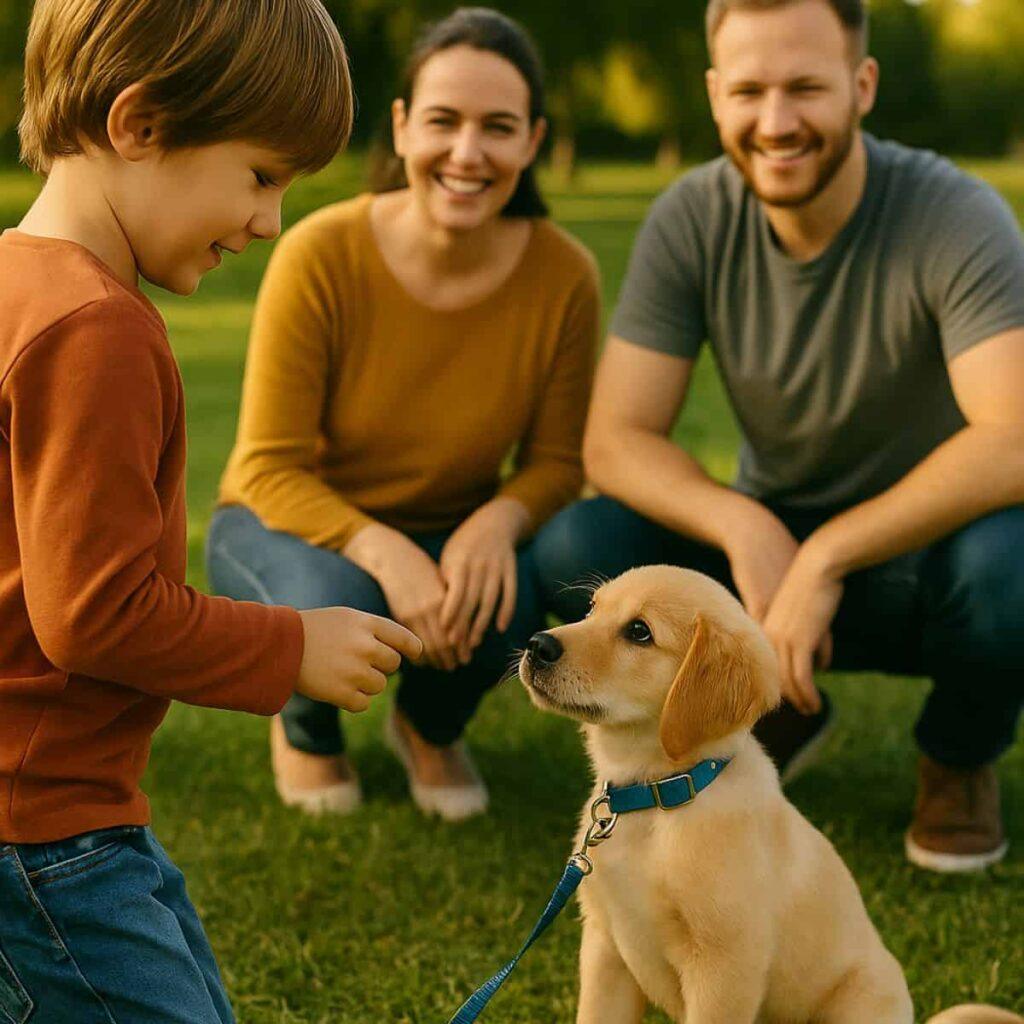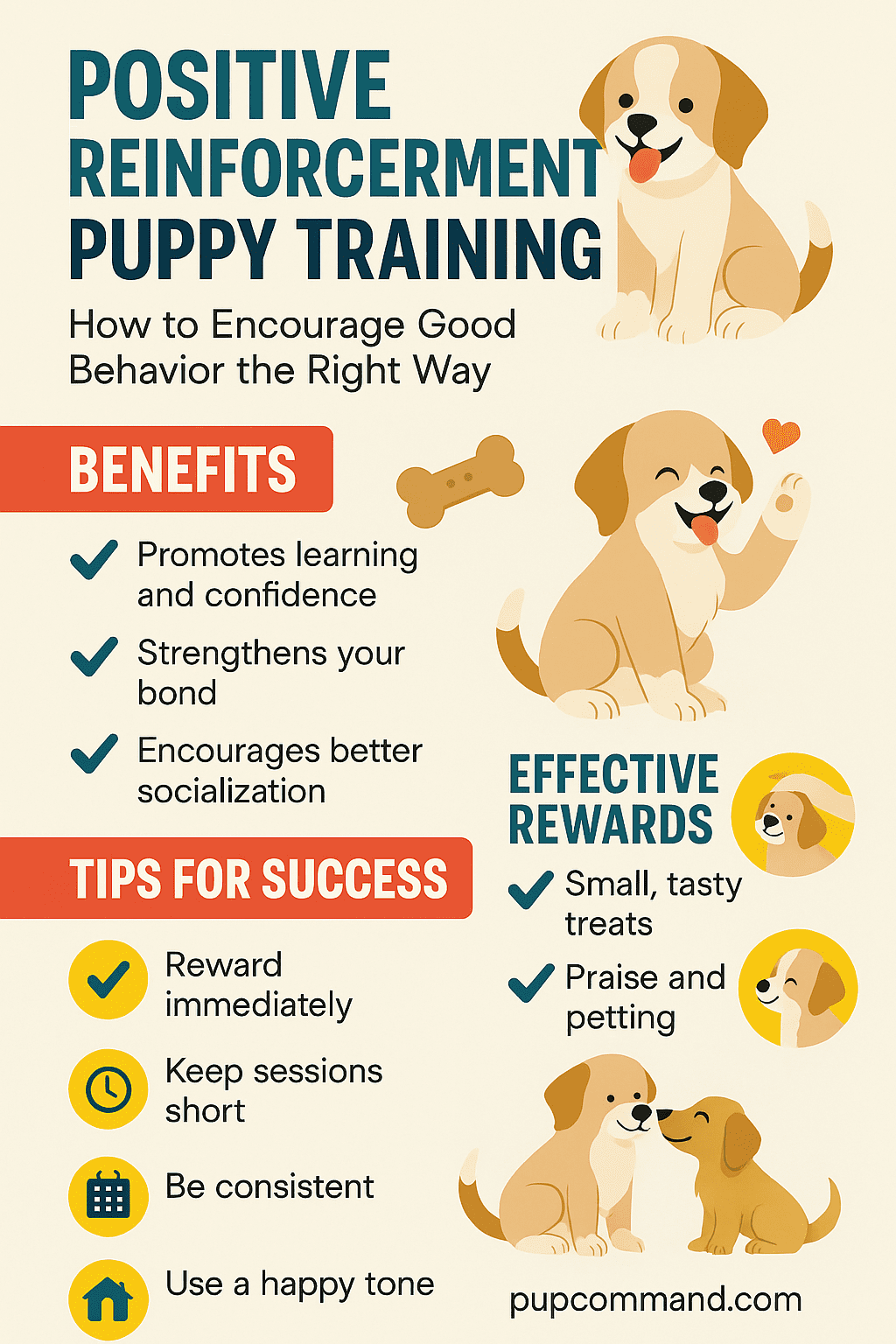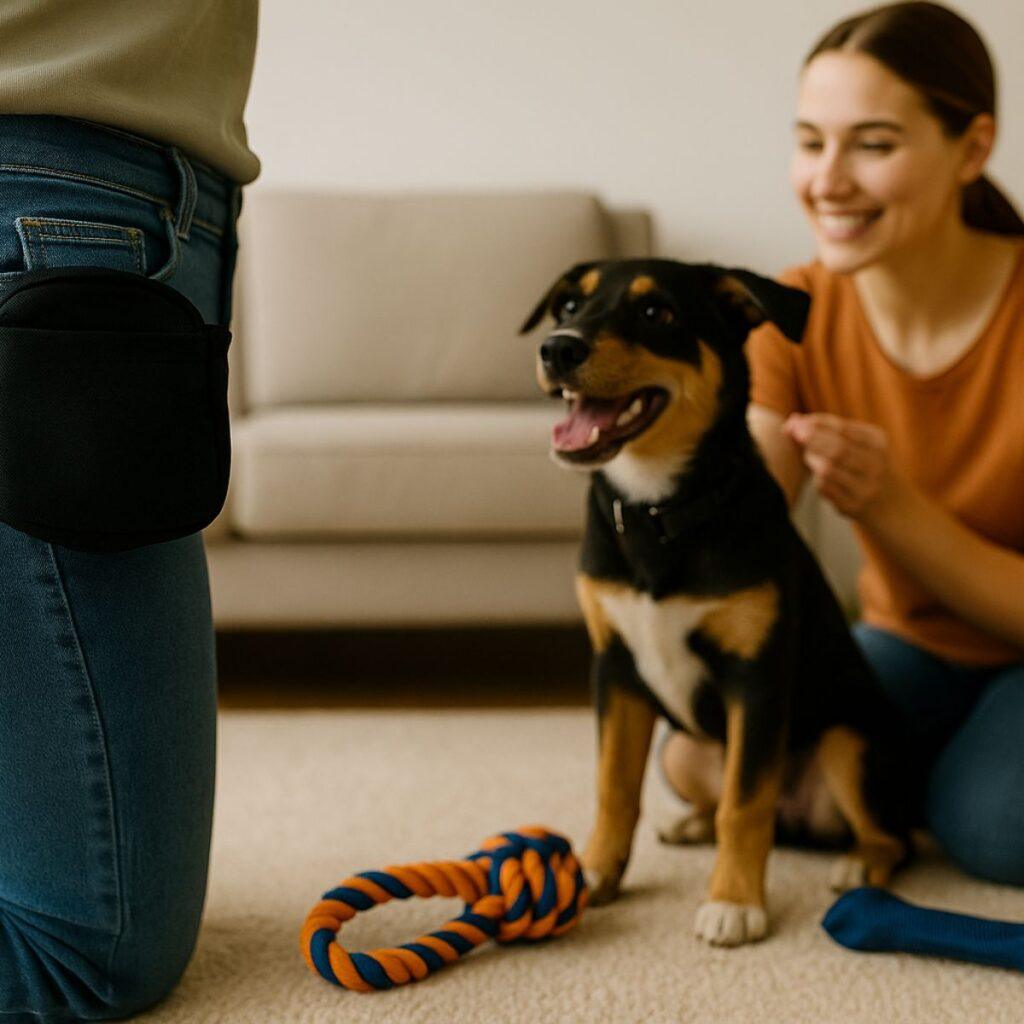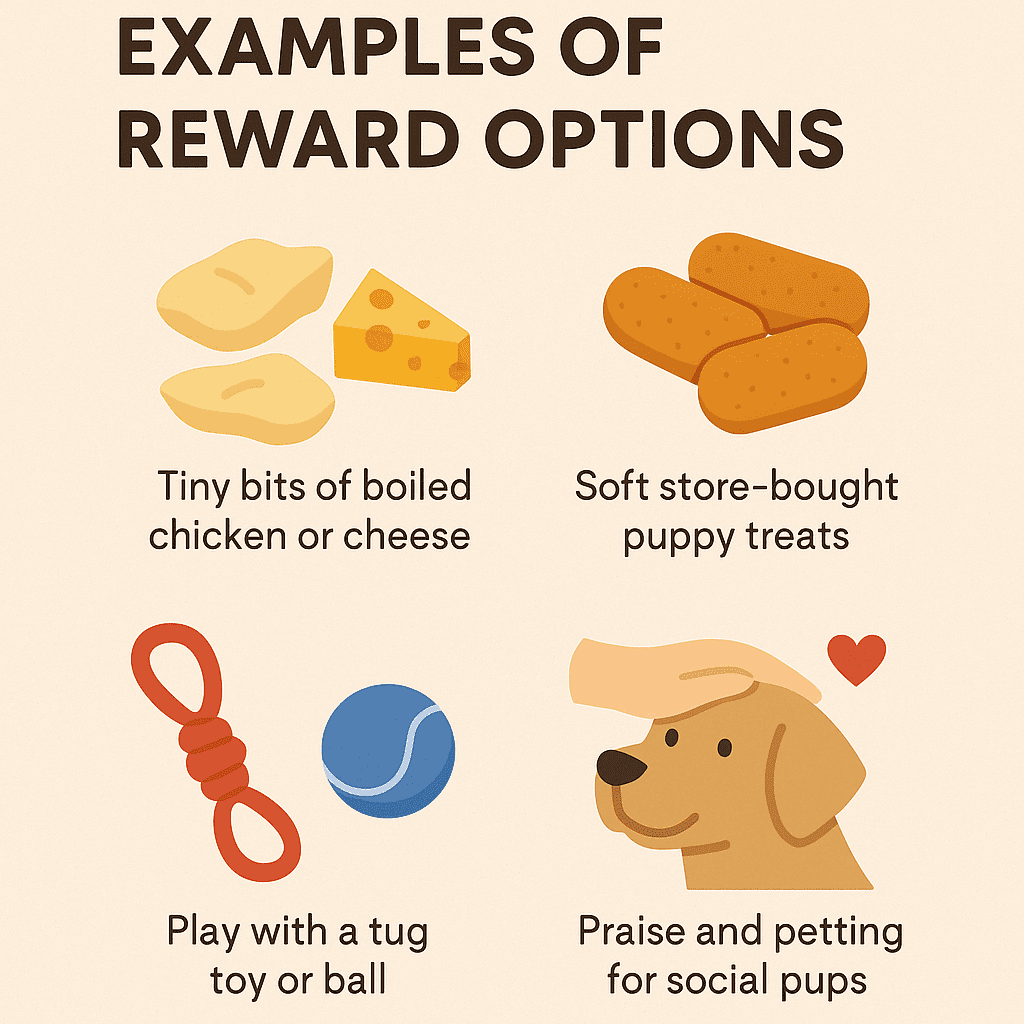What does Positive Reinforcement Puppy Training Really Mean?

The Long-Term Payoff of Positive Reinforcement Puppy Training
Positive reinforcement puppy training builds trust, resilience, and a confident learner. Puppies trained this way are more likely to:
- 💡 Make good choices on their own
- 🐾 Show fewer behavior problems over time
- 🧠 Learn faster because they feel safe trying new things
Instead of shutting down in fear, they experiment—and learning accelerates.
Examples Beyond Treats: Real-Life Rewards in Action
- 🚪 You say “sit” before opening a door → puppy sits → door opens = reward
- 🐕 You call your pup → they come → leash is clipped off = freedom
- 🛏️ You ask for “down” → pup lies on their mat → gets a chew toy = reinforcement
These are functional rewards—life rewards—your dog cares about. They work just as powerfully as food.
Why Positive Reinforcement Builds Stronger Relationships
This method isn’t just about obedience—it’s about partnership. Instead of control, you offer clarity. Instead of fear, you build focus.
Dogs trained with positive methods:
- 👁️ Look to you for direction
- 🎯 Respond faster under pressure
- ❤️ Trust you even in new or stressful situations
A Quick Science Recap
Behavior science uses the term “positive” to mean added—but in practice, it’s also about being constructive.
- 🛑 Positive punishment = adding pain (e.g., leash jerk)
- ✅ Positive reinforcement = adding reward (e.g., praise, treat, play)
Only one of those improves the bond between you and your dog.
Why Positive Punishment Backfires Long-Term
It may work today—but it costs tomorrow. Punishment can:
- 🧨 Suppress behavior without addressing root causes
- ⚠️ Increase stress, which makes problems worse
- 🚫 Damage the relationship and reduce the dog’s confidence
The fallout? A dog who listens… but doesn’t trust.
- Suppresses behavior temporarily, without solving the cause
- Erodes trust and increases anxiety
- Can make dogs hide behavior until it’s worse (e.g., biting with no warning)
What Lasts Longer: Fear or Understanding?
Understanding always wins. When your dog learns through reinforcement, they offer better behavior more often and with less stress. They trust you—and want to work with you.

📚Dr. Ian Dunbar on why punishment fails long-term
Still unsure? Consider one of the field’s most respected experts: Dr. Ian Dunbar. A pioneer in modern dog training, Dr. Dunbar introduced science-based, fear-free methods to the public decades before most pet owners understood their power. He’s helped shape the training principles used by behaviorists worldwide.
Dr. Ian Dunbar is widely considered one of the most influential figures in modern dog training, especially in the realm of positive reinforcement. This is a man who’s trained everything from shelter puppies to wild animals—and earned trust, not fear, every step of the way.
How to Use Positive Reinforcement the Right Way

Step 1: Pick Your Rewards Wisely
Step 1: Use High-Value Rewards
Your puppy won’t work for just anything. Use top-tier motivators to build fast, reliable behaviors.
🔑 High-Value Reward Options:
- 🍗 Tiny bits of boiled chicken or cheese
- 🦴 Soft, moist puppy treats (easy to chew, fast to eat)
- 🎾 A quick game of tug or fetch
- 🐶 Praise and petting (for pups who crave connection)
📌 Trainer Tip: Keep rewards on you at all times. A treat pouch on your hip = instant feedback and faster learning.
Step 2: Master the “Magic 3” Commands
These are the non-negotiables of puppy obedience. Nail these first.
1. Sit – The Foundation of Calm
- Lure treat above puppy’s head
- Butt touches floor = treat delivered
- Reinforces stillness and patience
2. Come – The Safety Net
- Say their name in an excited tone
- When they arrive: treat at your feet
- ❗ Never scold for delay—make coming to you a rewarding event
3. Leave It – The Self-Control Superpower
- Show a boring treat
- Say “leave it”
- Reward with something better when they ignore the first
🧠 Training Cadence:
🎮 Always end on a win. Always make it fun.
🕐 5-minute sessions
📅 2–3 times daily
Positive Reinforcement Puppy Training Milestone Progress Tracker
| Age | Focus Area | Goal |
|---|---|---|
| Week 1–2 | Name & Reward Basics | Responds to name, accepts food as reward |
| Week 3–4 | Crate & Potty Training | Settles in crate, predictable potty schedule |
| Week 5–6 | Sit, Come, Leave It | Basic commands introduced & reinforced |
| Week 7–8 | Public Practice & Distractions | Commands hold in new environments |
| Week 9+ | Problem Solving & Confidence | Calm behavior, consistent response |
Q: What if my puppy isn’t food motivated?
A: Every puppy is motivated—you just need to find the right currency. Try:
- 🧸 Tug toys
- 🎾 Fetch or chase games
- 🎉 Over-the-top praise
- 🏃 Movement and freedom (e.g., running with you)
Pro Tip: For high-drive pups, the action is the reward.

Q: When do I stop using treats?
A: After your dog fully understands the behavior, begin to reduce treat frequency. But never stop completely. Think:
- 🎰 Random rewards = stronger habits
- 📉 Fade out gradually, keep it unpredictable
Q: Why does my dog ignore me outside?
A: You’re battling distractions:
- 🐿️ Squirrels
- 🐕🦺 Other dogs
- 🦴 Smells galore
Start small:
- Begin in quiet places
- Slowly introduce more challenges
- Always set them up to win
Q: My puppy only listens at home. What gives?
A: Dogs don’t generalize behavior automatically. Solution:
- 📍 Train in multiple locations
- 🚶 Add variety to your sessions
- 🔁 Repeat commands in new contexts
Q: How do I stop biting and chewing?
A: Biting is natural. Fix it with redirection:
- 🪀 Offer a chew toy before they bite
- ❌ Don’t punish—interrupt and redirect
- 🧠 Consistency rewires habits
Q: Is it okay to say “no”? Should I punish?
A: “No” is okay, but it must be paired with guidance:
🔄 Replace the bad behavior with a good one
👎 Saying “no” alone = confusion
👉 Instead: stop, redirect, and reward the right action
🛠️ Download My Free Positive Puppy Crate Training Cheat Sheet
The Science Behind Positive Reinforcement
Positive reinforcement puppy training is grounded in behavioral psychology. It taps into operant conditioning, a method discovered by B.F. Skinner. When puppies receive a reward for a specific behavior, they form a neural connection that links that action to a positive outcome—literally rewiring their brain for success.
Common Mistakes to Avoid
Even well-intentioned trainers can misfire. Watch for these errors:
- ❌ Timing the reward too late – If it’s more than 2 seconds after the behavior, your puppy might not understand what they’re being rewarded for.
- ❌ Inconsistent rewards – Rewarding sometimes but not others confuses your pup and slows learning.
- ❌ Reinforcing the wrong behavior – Accidentally giving a treat when the dog jumps up? You just rewarded jumping.
Beyond Treats: Alternative Rewards
Your Dog Deserves More Than “Sit” and “Stay”
Transform their life (and yours) with step-by-step guidance from the Dogo app — the world’s smartest training companion, built by certified dog behaviorists.
🐶 Try Dogo App – Free to StartPositive reinforcement puppy training doesn’t have to mean a treat every time.
- 🎾 A quick game of tug
- 🐾 Access to sniff or explore
- 🗣️ Verbal praise in a happy tone
- 🤝 Physical affection (for dogs who love it)
Training this way teaches your puppy that good things come from good choices—a lesson that builds lifetime loyalty and calm, confident behavior.
Final Thought: You’re Building More Than Behavior
Every interaction is a lesson. With positive reinforcement puppy training, you’re not just teaching manners—you’re building trust, resilience, and a lasting bond.
🐾 Your pup’s future is in your hands. Lead with guidance, not fear.
🧠 Trust. Repeat. Reward.
📚 Want to Master All 5 Training Principles?
Each method builds on the others. Explore them all to truly understand how dogs learn — and how to train with clarity, confidence, and compassion.
🎁 Ready to test your skills?
Get the Free Quiz Pack
